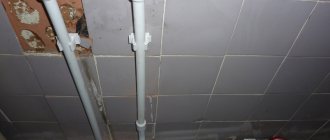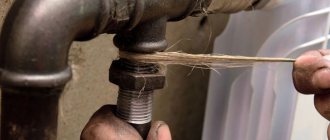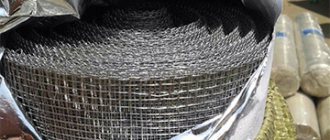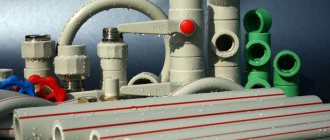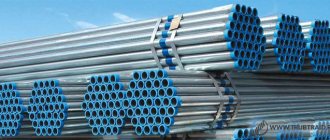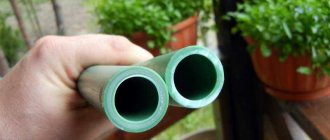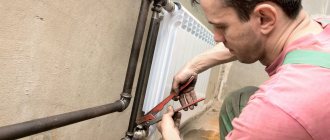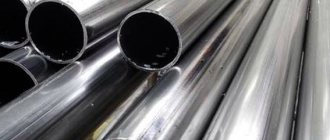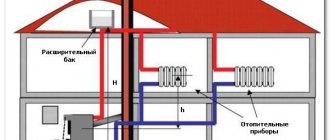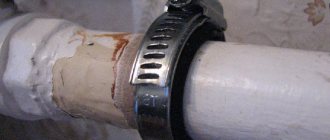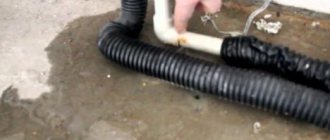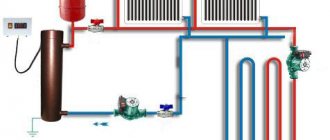How to connect metal pipes without welding and threading
When repairing and replacing apartment pipelines, or installing risers, not all connections can be welded. It is impossible to cut threads on a pipe that is close to the wall. For the joint, you will need devices for threadless connection of steel pipes.
Using them, they install main and process pipelines for transporting gas, oil, chemical reagents, and saturated steam. When connecting pipes without welding, the risk of corrosion damage to the joints is eliminated. The metal is protected by tightening linings; they form airtight joints.
Connecting pipes made of other materials
Soldering of polypropylene pipes
The connection of two pipes made of HDPE and plastic can also be carried out using welding (in this case it is called soldering) and using fittings.
When soldering, two methods are used:
- Butt.
- Using fittings.
The first option requires special equipment and can be performed by a highly qualified specialist. Butt soldering is used only when installing large-diameter pipelines, so it is not used when creating household communications. Soldering using connecting elements (electric welded or special) can be carried out independently.
Compression fittings
But most often they use connections without soldering. Special fittings are designed for this, such as:
- compression;
- reduction.
The first option is used when connecting pipes of the same diameter. Moreover, the pipes themselves can be made of different materials.
Reducing fitting
Reducing fittings are used when it is necessary to connect pipelines with different diameters.
The principle of their use is quite simple. A fitting is put on each end of the pipe. Then, using a wrench, tighten the nut. The result is a strong and removable connection.
Press fitting for metal-plastic pipes
Joining of metal-plastic pipes is carried out in two ways:
- Compression split fitting. During the installation process, the ends of the fitting are inserted into the pipe. They have rubber seals that keep them securely inside. Then the fitting is tightened with a collet and secured with a control nut. Such a connection can be subsequently disassembled.
- Press fitting. This method is used less frequently, since the joint is permanent. The fitting shanks are inserted into the pipe. Then, using a special device, the flexible cuff is crimped. The result is a strong and reliable connection.
Having familiarized yourself with the methods of connecting pipes, all that remains is to choose the product with which it will be most convenient for you to work.
Methods for connecting metal pipes without welding
Not all metals are welded well, and sometimes the quality of the seams is poor. Threaded joints are not tight enough, screw threads on metal are destroyed over time.
Weldless connections are technologically advanced. The devices are used on high-pressure gas pipelines when transporting heated media. To install seals, no preliminary preparation of joints or cutting of edges is required. It is enough to clean the ends from dirt and dust.
Methods for connecting metal pipes without welding:
- Clamp tie. A sealed, tight-fitting seal is used to seal leaks. Repairs can be done quickly.
- Flanged. The tightness of the plates is regulated by bolted fasteners, the tightness is ensured by a rubber gasket.
- Installation of the repair mounting clip. The joint is securely fixed in a small metal case.
- Using the Gebo coupling. The compression fitting is suitable for repeated use.
- Fastening fittings without threads. A permanent, hermetic connection of high strength is formed.
- Crab systems. Used for profile rolling.
For threadless connections, no special electrical or gas equipment is required; an installation tool is sufficient. To install the device, no technical training is required.
Welded joints
Welding is a very popular method of joining individual parts in a pipeline structure. This method is especially in demand when installing technical communications in factories.
The most commonly used method for installing steel pipelines is hot welding.
It is worth noting that not only individual parts in metal structures, but also plastic products can be connected by welding. In some cases, welding is also used to join glass parts.
Depending on the method of exposure to the material, there are two main methods of such connection:
- fusion welding;
- pressure welding.
Fusion welding has many implementation options:
- electric arc;
- simple electric;
- electrobeam;
- laser;
- gas welding.
The most popular among these options is the first one. The use of electric arc welding implies that the heating source is an electric arc. This type of work can be performed in two ways:
- with alternating current;
- with direct current.
Helpful information! Butt welding of the connected pipeline elements allows the work to be carried out at lower financial costs. This is due to the fact that welding equipment is less expensive and also requires less energy consumption during installation.
Metal welding can be done with electric or gas equipment
This type of installation can be carried out using various equipment, so three types of welding can be distinguished:
- manual;
- semi-automatic;
- automatic.
Types of welded joints
There are different methods for welding individual parts in pipeline communications. Let's look at them:
- end-to-end;
- overlap;
- corner;
- with welding of various elements.
The most popular and common are the following welding connections:
- Butt (longitudinal and transverse). With this welding option, backing elements - rings - can be used. The seam in such joints can be one- or two-sided. The latter is used in cases where the part has a large cross-section - more than 500 mm.
- Angular (one-sided and two-sided). This option can be done in different ways. In some cases, corner joints are welded with an edge bevel, and in others - without it.
- Socket-welded overlap clutch. The socket connection is used to join pipeline elements with a high ductility coefficient. These include parts made of non-ferrous metals, as well as plastic elements.
In addition, square pipes, which are used in construction and the production of various furniture, are also connected by welding. They are not suitable for installation of pipelines. This is due to the shape of their cross-section - it worsens the flow characteristics, while round is the best option for pipeline structures.
Butt welding is used for pipes whose diameter exceeds 50 mm
Connection using fittings
Mounting elements used in pipeline assembly vary in type and scope. Types of fittings:
- straight lines are intended for joining two system elements in the same plane;
- adapters are needed when connecting workpieces of different diameters; they are often necessary when repairing old pipelines;
- rotary, allow you to change the direction of flow;
- end caps are necessary when changing the pipeline layout;
- adjustable (tees, crosses) are needed when inserting into main lines or when installing bends;
- fittings – flexible fittings used when connecting to shut-off valves.
For fitting connections without threads, crimp or compression fittings are used. The design includes a sealing ring and is secured with an adjustable clamp. With the help of such fittings it is easy to connect pipes without welding. The joint is tightly and hermetically fixed on both sides. The strength of such a connection is superior to a welding seam. Fittings are used when installing pipes in technological systems where high pressure is created. They are used for plumbing and heating systems installation. No special equipment is required to fix the fittings. They are produced for plastic and metal pipes.
How to connect two pipes of the same diameter: current methods for independent implementation
In this article we will look at the instructions for connecting one-size pipes made of different materials. The topic of the article is interesting, since the market offers a wide range of different pipes, which differ from each other not only in operational and technical characteristics, but also in different methods of joining into a single system.
But, before considering the specifics of installation work, let’s consider what types of plumbing accessories can be purchased.
The figure shows a threaded connection of heating pipes made using a coupling
Classification
Dismountable connection of profile pipes with bolts during greenhouse construction
All water pipes, in accordance with the production materials used in their manufacture, are divided into the following categories:
- metal modifications;
- polymer modifications;
- metal-plastic products.
Important: Each of these modifications is presented on the market with a wide range of products, which are characterized by one or another connection method. Therefore, when planning the installation of water supply in your apartment or country house, you need to take the choice of materials and connection methods with maximum responsibility, since the price, durability and appearance of the finished system largely depend on this.
So, let's look at how to independently connect the mixer to the pipe.
Joining of metal pipes
Threaded connection on a steel water pipe
In the process of installing metal (cast iron, steel and copper) plumbing and heating systems, threaded and welded joints are used.
Let's look at each of these methods in detail:
- Threaded installation, which, by the way, also includes American pipe connection, is a technology that allows you to assemble water pipes from elements with the same cross-sectional diameters.
To do this, a thread is cut at the ends of both pipes, over which a special metal coupling is screwed - a fitting. Using special fittings, you can assemble both straight and curved plumbing and heating systems.
The fitting used on such structures has an internal thread, while the pipes have an external thread. If fittings for installation are purchased with already cut threads, then on the joined elements you will have to cut them yourself using dies.
Among the advantages of the technology, we note the strength and durability of the finished result. In addition, if necessary, the threaded fitting can be unscrewed and the entire structure can be disassembled in order to repair the damage or redo it.
Important: As a rule, standard threads are used on pipes and fittings. But if you purchase foreign-made accessories from little-known brands, you need to make sure that the product will correspond to the metric thread type.
- Installation of plumbing systems using welding is rarely used. The main disadvantage of a welded joint is the impossibility of making it yourself, since a professional welder with special equipment and experience in using this equipment can handle such work.
To install two pipes of the same size, the following types of welded joints are used:
- transverse butt (without boring or with internal boring) with a backing ring;
- longitudinal butt (without edge bevel or with bevel) with one-sided seam;
- transverse butt with one-sided seam;
- one-sided corner;
- double-sided corner;
- socket overlap.
The butt joint is the most common, as the finished result is characterized by high strength, provided that the joined elements are correctly centered.
If a water pipe with an internal diameter of up to 500 mm is being assembled, a one-sided seam is welded, the strength of which is quite sufficient. If the diameter is larger, the root of the seam is welded from the inside, resulting in increased strength of the joint.
A weld is considered the optimal type of connection when installing industrial water pipelines, but it is used extremely rarely in everyday life due to the high cost of the finished version and cramped conditions for using a welding machine.
Brazing of copper components is a technique used in the assembly of premium plumbing systems.
The installation principle is as follows:
- the ends of the joined elements are cleaned and covered with solder;
- the inner surface of the fitting is cleaned and coated with solder;
- the pipe is inserted into the fitting and heated with a burner;
- After the solder cools, a strong and durable coupling joint is obtained.
Types of connection of polymer products
The diagram shows a step-by-step connection of corrugated pipes
If the question is how to connect HDPE pipes, then in this case the installation is much simpler than assembling a metal water supply system. No threads are cut on the plastic, and installation is carried out using two methods: by soldering or using fittings.
- Connecting HDPE pipes using fittings is popular when assembling household water supply and sewer systems. The relevance of the method is not surprising, since the fittings, regardless of modification, can be installed even by a novice plumber.
Fittings, according to their design features, are divided into the following categories:
- Crimp modifications are simple yet effective and versatile mounting accessories. For installation, special pliers are used to evenly distribute the applied force along the entire perimeter of the crimp collar.
- Press fittings are the most reliable, as they guarantee a complete absence of leaks.
The picture shows a connection of PVC pipes using compression fittings
Installation is carried out using a special device. Fittings of this type are installed, first of all, for installing a water supply system with subsequent embedding into a wall or floor screed.
- Push fittings are the optimal solution if ease of installation work is required. Connecting elements are used to make it possible to disassemble the structure during operation.
- The welded connection of propylene pipes using special equipment is carried out end-to-end or using plastic fittings.
The photo shows welding using a hand soldering iron.
Butt welding is relevant when installing large-diameter water supply and sewer systems. For another type of welding, an electric welding coupling or special fittings are used.
In both cases, the surfaces being connected are melted, and as the plastic cools, a reliable, almost monolithic joint is formed.
Installation of metal-plastic water pipes
Push-in fitting with union nut
The joining of metal-plastic pipes is carried out using the following connecting elements:
- Push-in compression detachable fittings - during the installation process they are inserted into the hole with a shank, tightened with a collet and secured with a union nut. The shank of the connecting element is equipped with rubber sealing rings, which are compressed by the compressed pipe and provide the required level of tightness.
- One-piece press fittings are a single-use mating accessory. The fitting shank, equipped with O-rings, is inserted into the pipe until it stops. Then, using special pliers, the flexible cuff is crimped, which acts as a union nut.
Conclusion
Now you know how to connect PVC pipes or their metal analogues. The information obtained can be applied in practice when choosing pipes and connecting elements to replace the water supply in an apartment or country house.
More useful information can be found by watching the video in this article.
Using the Gebo coupling
A special compression device will help you connect a metal pipe without welding. The Gebo coupling is a metal flange with a nut, inside of which there are three rings: a cone-shaped clamping ring, a clamping ring, and a sealing ring. To create a strong connection, it is important to adhere to installation technology.
The main stages of fastening the coupling:
- Preparation of the ends includes:
— removing a layer of paint or enamel, removing the protective layer from galvanized pipes (the coupling protects the connection from oxidation).
- A nut and a clamping ring are put on one of the workpieces, with the upper part of the cone directed towards the nut.
- The Gebo coupling is assembled: a pressure ring is put on the sealing ring, then a sealing ring, it is turned towards the body, put on another pipe, and inserted into the body.
- The coupling is first compressed until immobile so that the nut does not turn. It is tightened, leaving several turns.
- Check the tightness of the joint. After this, the nut is screwed in completely.
The coupling body is made of durable stainless steel or non-ferrous metal. The fasteners can be used after dismantling the pipeline; it is enough to replace the sealing rubber ring.
Flange connection
Flanges are a thick disk with a central hole equal to the diameter of the pipe and side holes for bolting. Flanges are installed in areas that need to be inspected periodically:
- when inserting removable plugs, the flange is welded to them at the factory;
- for installation of metering devices (water meters, heat meters);
- installation of shut-off valves (various valves, taps).
A detachable threadless connection of metal pipes is formed by tightly fitting disks onto the edges of the pipes. When the plates are pulled together by a rubber ring gasket, a sealed butt joint is created that can withstand high pressure. The seal between the flanges on water pipes is replaced when leaks occur. When transporting hot or ammonia media (sewage) once every three to five years.
Dark Steel
Welding
The main method of connecting metal pipes is welding, electric arc or gas.
- Arc welding is the fusing of electrode material, melted by an electric arc, with insulation of the seam with molten slag - the electrode shell. Enormous currents (200 amperes or more) are provided by a welding transformer.
- Gas welding involves the use of a torch flame to which a mixture of acetylene and oxygen is supplied to melt the edges of the seam. The welding material is provided by welding wire melted in the same flame.
Threads
A threaded connection, unlike a welded one, allows for disassembly. The threads on the edges of the pipes are cut manually, on a screw-cutting lathe or.
To seal threads the following can be used:
- FUM tape. It is inconvenient because it allows leakage with minimal thread reverse.
- Thread - sealant for connecting water pipes does not have this drawback; but not everyone will like the price of 150-200 rubles for 30 meters of thread.
- Plumbing linen is inexpensive, but not too durable: it rots in cold water and fades in warm water.
But: impregnation with paint, drying oil or silicone sealant eliminates this problem, making winding with flax strands very durable.
Quick release fittings
The fitting for a metal pipe is a simple design with a union nut, a spacer ring and a rubber or silicone ring gasket. When the nut is tightened, the pipe is securely pressed against the O-ring.
The price of a quick-release fitting starts from approximately 150 rubles; its installation requires careful cleaning of the pipe surface from paint and rust.
Installation of repair and mounting clips
Strong non-welding joints are obtained by using special pipe linings that are pulled together. In fact, a repair and installation clip is a type of clamp. It is installed in emergency areas. The peculiarity of this method of threadless connection is its versatility. There are tee clips and crosses. The cast body in the form of two halves of the bushing is easy to install, just put the holder on the pipe, tighten 4 bolts - there are holes for them in the corner lugs. The tightness is ensured by a rubber seal - a piece of hose cut lengthwise.
Clamps are used for process pipelines where leaks need to be quickly eliminated. They can be installed for a long period or until the next repair. Before assembly, the cast body is disassembled to create two halves. Place on the joint or fragment being repaired so that the gaskets fit the pipe tightly. After this, the bolts are inserted into the ears and the nuts are tightened on them. Clips are considered a consumable item by plumbers.
Crab systems for profile pipes
When installing pipes of rectangular or square cross-section, fastening structures are used. They are two stamped plates held together by bolts. When folded, the two halves form a profile that matches the size of the pipe.
Crab systems are used in the creation of metal structures; they reliably fix the workpieces in the desired position. Types of systems:
- angular or L-shaped, they connect the profile at right angles;
- T-type with three profile holes;
- cross or X-shaped.
Crab systems reduce frame assembly time. No special training or equipment is required for installation. Enough tools. Crab systems are convenient:
- for street structures;
- billboards;
- sports and play outdoor equipment.
Crab systems are not used for pipelines. Standard size bolts and nuts are used for installation. Fastening brackets are produced in rectangular and square profile sizes.
Application of clamps
Universal pads are put on cracks to eliminate leaks. They can connect pipes without welding threads. For tightness, sealing gaskets are used. Clamps are made of metal or dense sealed material. In terms of connection strength, clamps are comparable to welding. Overlay designs:
- wide and narrow in the form of split rings with holes for bolts;
- in the form of a metal bracket that secures a sealed gasket;
- complex geometry for fastening to a wall or two pipelines together.
Clamps for eliminating leaks are made from scrap materials. Fixed to the pipe with tape or wire.
There are many ways of mechanical connection. You can always choose something suitable for the situation. And the welding machine may not be available during the installation of a pipeline or metal structure.
Source
Heating pipe connection
The radiator piping must include shut-off valves
We already know how to choose the best bimetallic radiator, and today we’ll talk about connecting heating radiators to pipes. In a heating system, threads are often used to connect elements. All equipment is installed on the circuit using threads. This includes an expanzomat (a metal tank with a rubber membrane inside), a pump, batteries, and the same meters. Metal lines can also be connected with threaded couplings. At the same time, there are different types of threads and methods of sealing connections. Let's figure out how to properly connect heating pipes to each other and to the batteries.
Which pipes to choose for heating?
Modern heating systems are installed on the basis of two types of pipes - metal and plastic. Metal pipes are represented by products made of stainless steel and copper, and plastic pipelines are based on polypropylene (PP) and polyethylene (PE) pipes. Which one is preferable for a particular heating system must be decided by a specialist. If you do not have the appropriate education, then it is advisable to seek help from an engineer who will help develop a project taking into account the required efficiency, heat losses of the building and other key parameters.
Each type of pipe has its own advantages:
- plastic pipes are cheaper, weigh less, are easy to install, and do not corrode;
- metal pipes are characterized by a long service life and operational reliability, able to withstand water hammer in the system and high coolant temperatures.
But each type of pipe has some disadvantages:
- plastic pipes have certain technical restrictions on the temperature and pressure of the working environment, have a shorter service life, and are vulnerable to various negative factors (ultraviolet radiation, chemical impurities in water);
- metal pipes are more expensive, susceptible to corrosion, and require more sophisticated equipment and tools for installation.
Important! When choosing pipes for installing a heating system, you should also take into account the thermal expansion to which plastic pipes are subject. The physical properties of plastic cause the distance between molecules to increase when heated, which is why, when filled with hot water, pipes can increase in length up to 2 cm and sag.
Types of carving
Steel pipes can be connected by welding or pipe threads. Connection of heating radiators to pipes is carried out only with metric threads, which are cut on the nuts. To assemble individual parts of a stainless steel metal line together, threaded connections of heating pipes are used, which are:
- conical (BSPT);
- cylindrical (BSPP).
In heating systems, conical threaded connections of heating pipes are used, and cylindrical ones are used only for drains. Cutting is carried out using a tool called a clamp. They are manual and electric. A hand tool consists of a handle, a ratchet and a head with cutting teeth. The presence of a ratchet allows you to work in hard-to-reach places, for example, in the section where the main runs along the wall.
To cut a thread, you need to chamfer and treat the surface with oil. In the process of cutting threads on a heating pipe, oil must be added, this reduces friction and heating of the part. In order for the joint to be airtight after connection, it must be sealed. The metric threads on the nuts of all circuit elements are also sealed.
Installation of steel heating pipelines
The process of installing heating pipes from steel pipes can be carried out in two ways: threaded and welded. Both methods are quite reliable, but quite complex from a technological point of view, and therefore require the involvement of professionals to implement them.
When connecting steel pipes by means of threaded twisting, threads must first be cut into the ends of the joined products, after which they are connected to each other using couplings, fittings, bends and other intermediate products, the quality of which must be given special attention.
The use of winding is mandatory for a threaded connection. For this purpose, it is better to use fum tape or plumbing polymer thread. Linen winding can be used for stainless steel pipes.
For ordinary steel pipes, flax is not recommended as a winding material, since constant moisture at the threaded connection can lead to corrosion.
The connection method by welding is even more reliable, however, unlike threaded connections, it is permanent, that is, disassembling the connection if necessary becomes impossible.
The process of welding steel pipes can only be carried out by qualified specialists. This work requires special welding equipment, the operation of which is significant and inaccessible to those who do not have professional skills.
In general, when carrying out welding work, you must adhere to the following important rules:
- Installation of heating using steel pipes should begin with the installation of a riser; and then it is from the side of the riser that the pipeline should be laid. However, in most cases, work in residential buildings is not carried out from scratch, but comes down to replacing outdated heating communications. Therefore, depending on the situation, the welding process may have certain features.
- Galvanized steel pipes are welded using self-shielding wire with a diameter of about 1 millimeter. In some cases, it is possible to use electrodes with a diameter of up to 3 millimeters, having a rutile or calcium fluoride coating.
- The connection of non-galvanized steel pipes for heating, which at home usually have a diameter of no more than 25 millimeters, is most often made with an overlap. The assembly of such pipelines by butt welding is carried out only at enterprises.
- The weld seam when connecting steel pipes must be smooth in relation to the surface of the products being connected, and not have sagging, cracks or other defects and flaws (read: “Options for welding galvanized pipes - advantages and disadvantages of methods”).
Types of seals
Previously, there was not such a variety of seals as there is today. Some plumbers use the entire range of materials in their work, while there are conservatives who still recognize only linen. Are they right? Let's figure it out. How to seal the threads on a heating pipe:
- tape-fum;
- flax with paste;
- anaerobic adhesive sealant;
- sealing thread.
Linen was previously used in tandem with red lead, grease or oil paint. Today, a special sealing paste is used that prevents the flax from drying out and rotting.
Flax dries in systems with hot coolant, but rots in cold water. In the first and second cases, the result of the process will be the appearance of a leak. Thanks to the paste, the fitting can be loosened a little after twisting, turning back no more than 45 degrees. A universal material, suitable for connecting metal heating pipes and polymers.
Flax is suitable for all types of threads on heating pipes, regardless of diameter. It is the cheapest of the seals. It is important to wind it correctly:
- using a metal blade or a file, notches are made on the thread;
- a strand of flax is rolled into something like a thread;
- winding is carried out as the fitting is screwed in (usually clockwise);
- The protective paste is applied evenly.
When winding flax, it is important not to overdo it. First you need to make the first turn, which will secure the seal to the thread. This leaves a tail. On the second turn, the remaining tail is picked up and wound together with the common fiber. Make sure there are no twists. The material should be distributed evenly along the threads from the end to the fitting body. When working with flax, when connecting heating pipes, you need to watch your hands, as they are constantly smeared with paste. If you grasp a polypropylene pipe with such hands, an imprint will remain.
Fum tape is used for thin-walled fittings and connectors with fine threads. The material is easy to work with and your hands are always clean. At the same time, fum tape is quite expensive and is mainly used for small diameters. A significant drawback of this seal is the impossibility of adjustment. That is, if the joint of the heating pipes is twisted and needs to be loosened a little to center it, then the connection loses its tightness.
Connecting metal pipes
Welding metal pipes
To connect two metal pipes, you can use two methods:
- welding;
- threaded connection.
The first option has recently been used less and less. The fact is that welding requires the use of special equipment - a welding machine. Also, such work must be carried out by a specially trained specialist.
The connection itself can be made using various methods:
- transverse butt;
- longitudinal butt;
- one-sided corner;
- double-sided corner;
- socket overlap, etc.
Most of these terms are familiar only to specialists. Therefore, if you decide to connect the pipeline using electric welding, then it is better to call a specialist. The joints themselves are strong and reliable (provided the work is done well).
Soldering copper pipes
If copper pipes are used, the soldering method is used. Such pipelines are mainly used in luxury buildings (copper is very expensive). Therefore, you cannot do without a highly qualified specialist, although if you read the article “Soldering copper pipes with your own hands,” you can try.
A more common method is a threaded connection. Anyone can assemble any pipeline using this method. In this case, the assembled structure can be either straight or with turns and bends. To do this, a thread is cut at the ends of the pipes and a special lock nut is screwed on.
Cutting threads on a pipe by hand
The thread can be cut both in a factory and at home, because when installing pipelines it is often necessary to cut pipes, in this case you can do the cutting yourself. For this, most often, a special device is used - a clamp. This is a special, small tool made of highly durable material. By screwing this device onto the pipe, a thread is cut on it.
Klupp
The locknut is screwed onto the pipe joints. The result is a strong and reliable connection. Tow or fum tape wound around the thread is used as a sealing material.
You can also find a connection without using nuts. In this case, fum or tow is wound onto the threads and the pipes are screwed into the purchased coupling with internal thread.
Pipeline installation diagram on a threaded connection
Among the advantages of this method of connecting two pipes are its simplicity (all work is carried out without welding), reliability and disassembly of the resulting joint. Namely, these are the properties that are needed when creating indoor pipelines.
